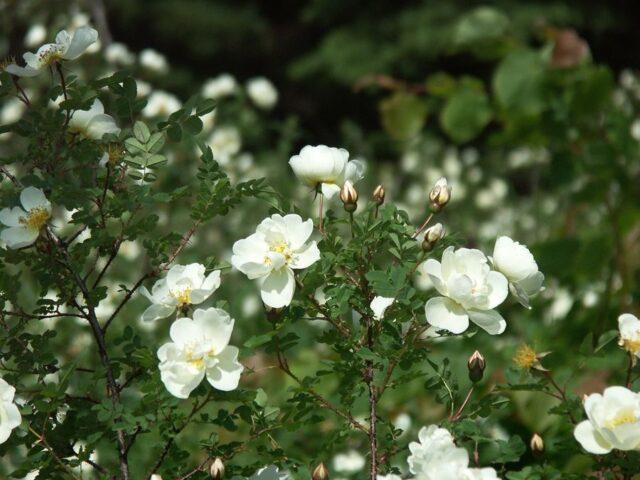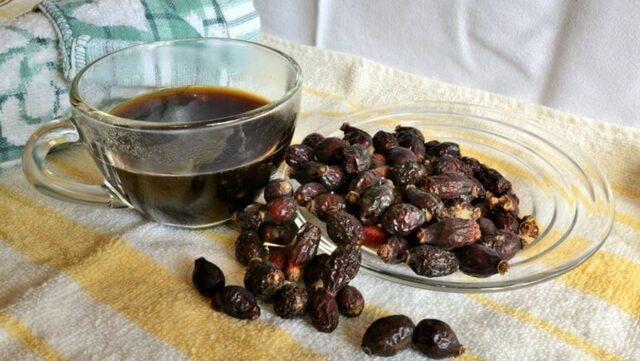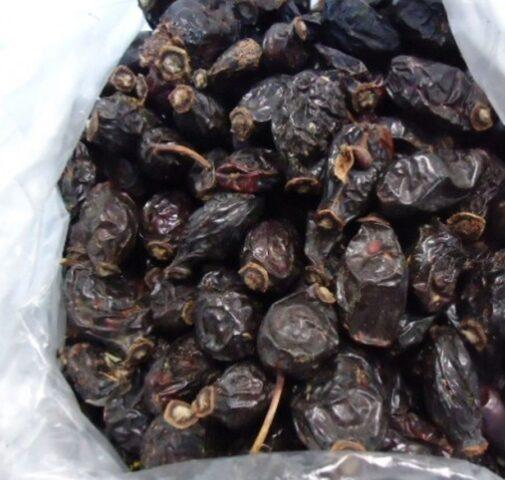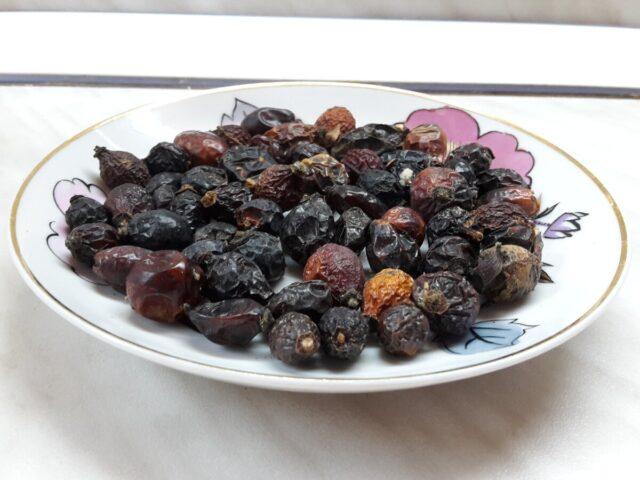Content
- 1 Is there a black rosehip
- 2 What is the name of the rosehip with black fruits
- 3 What does the black rosehip look like and where does it grow?
- 4 Types of black rose hips
- 5 Chemical composition
- 6 What is useful and what helps black rosehip
- 7 Contraindications to the use of black rosehip
- 8 When and how to collect black rose hips
- 9 Terms and conditions of storage
- 10 Conclusion
Black Rosehip is a useful and beautiful plant with numerous medicinal properties. Under natural conditions, the culture is much less common than varieties with ordinary red fruits. But the value of the shrub only increases from this.
Is there a black rosehip
Most rose hips produce dark orange and red oval or elongated fruits. But in the wild and in decorative breeding, you can also find a shrub with black berries.
In terms of composition and properties, the variety is very similar to ordinary red. The plant has similar requirements for soil and light, and is used to treat the same ailments. However, there are nuances that make shrub berries more useful for a number of diseases.
What is the name of the rosehip with black fruits
In botany, the black rosehip is called the prickly rosehip (Rosa spinosissima). You can also find it under the names of femoral or thin-legged roses.
What does the black rosehip look like and where does it grow?
The black rose hip is widespread in Central Europe and in temperate climates in Asia. Possesses sprawling arcuate shoots, rises on average 2 m above the ground. The branches of the prickly rose hip, in accordance with the name, are abundantly covered with needles. The leaves of the shrub are odd-pinnate, on long petioles, in the summer they are dark green, and turn purple in the fall.

The decorative period of black rose hips lasts on average about two weeks.
In May and June, black rose hips bring single flowers up to 6 cm in diameter. Their shade is most often white, although sometimes it is yellowish or creamy. By autumn, the fruits ripen - spherical dark hypanthia with seeds, nuts inside. The flesh of the berries of the shrub is fibrous, covered with hard hairs. After ripening, the fruits do not crumble for a long time and remain on the branches until winter.
What is the difference between black rosehip and red
From the point of view of science, there are no fundamental differences between black and red rose hips. Plants belong to the same genus and family, have a similar external structure.
But at the same time, black rosehip fruits contain more vitamin C - about 80% of the daily value of 100 g. This is almost 10% more than in a similar amount of red berries.
Types of black rose hips
Black rose hips in their natural habitat are represented by two species:
- Rosa spinosissima Altaica. It has dark brown spiny shoots and light green serrated leaves. The flowers of the variety are simple in shape, white with golden yellow stamens, the shade of the fruit varies from maroon to pure black.It blooms once a season, grows naturally in Siberia and China.
The prickly rosehip of Alteika can withstand frosts down to -34 ° С
- Thorny femoral rose (Rosa spinosissima var.spinosissima). The shrub has flexible shoots with long, straight thorns, in spring it produces creamy white or slightly pinkish buds. In good conditions, it can be decorative until autumn. Differs in small openwork leaves, the fruits are shiny, spherical, black. The shrub withstands frosts well down to -37 ° C, prefers sandy soils.
Femoral thorny rose hips are found wild in Southwest Asia and Europe
In general, the two plant varieties are very similar to each other. The differences relate to the shade of the buds, the degree of endurance and some vegetative characteristics. In decorative breeding, the species are equally popular.
Chemical composition
Useful properties and photos of black rose hips are of interest due to the rich composition of the plant. The fruits, green parts and wood of the culture contain:
- vitamins B1, B2 and B9;
- vitamin C;
- tanning components;
- iron, zinc and magnesium;
- vitamins PP and K;
- organic acids;
- natural sugars;
- potassium and manganese;
- tocopherol;
- pectins;
- phosphorus and copper.
The use of black rose hips is useful for the prevention of diseases and in the treatment of ailments. In this case, the dosages should be moderate, since the concentration of active substances in the berries is very high.
What is useful and what helps black rosehip
Black rosehip has numerous medicinal properties. When consumed in small dosages, the plant:
- protects against the development of vitamin deficiency and anemia;
- promotes rapid recovery from acute respiratory viral infections;
- strengthens immune resistance;
- inhibits the growth of bacteria and fights inflammation;
- promotes the prolongation of youth due to antioxidant properties;
- strengthens the walls of blood vessels and normalizes the work of the myocardium;
- accelerates the healing of wounds, abrasions and cuts;
- cleanses the liver and improves its functioning.
Black rosehip is used as a prophylaxis for oncology. The plant supports healthy cellular processes and prevents the growth of malignant tumors.
Which rosehip is healthier - black or red
Both types of shrubs have valuable medicinal properties. Their fruits are used for the same diseases and are used in the same recipes.
At the same time, black rose hips contain much more vitamin C. For colds and inflammatory ailments, it is more useful and provides the fastest positive effect.
Black Rosehip for Immunity
With a weakened immune system, black rosehip tea helps well. You can prepare it according to this recipe:
- Ripe berries of the plant are washed and chopped by hand or using a blender.
- Put a mass in the amount of two large spoons in a teapot.
- Pour 200 ml of fresh boiling water for ten minutes.
Ready tea is poured through a strainer into cups and taken twice a day, 250 ml.
Infusion of black rosehip for colds
Fresh black rose hips quickly relieve fever in case of colds and improve general condition. The infusion on berries is done like this:
- The fruits are kneaded with a pestle so that they let the juice abundantly.
- The raw material is poured with boiling water in a ratio of 1: 6.
- In a glass container, put in a water bath for ten minutes.
- They are removed from the stove, covered with a lid and wrapped in towels for three hours.
The filtered product can be used with honey three times a day.

Black rose hips for colds eliminates nasal congestion and watery eyes
Black rose hips for gum disease
The antibacterial and healing properties of the plant help well with periodontal disease and mechanical trauma to the gums.For treatment, such a remedy is made:
- About 40 dry black berries are placed in a thermos.
- Pour 1 liter of fresh boiling water.
- Leave closed overnight.
- In the morning it is passed through cheesecloth for filtration.
You need to drink the drug 150-200 ml at a time twice a day.
Black rose hips from edema
Black rosehip has diuretic properties and helps to remove excess fluids from the body. To improve kidney function and eliminate edema, a decoction of plant roots is prepared:
- Grind two large tablespoons of dry raw materials.
- Pour 500 ml of boiling water.
- Simmer for about a quarter of an hour over low heat.
- Cool and filter.
You need to consume a decoction of 70 ml on an empty stomach three times a day. Sweeteners should not be added to the medicine.
Infusion of black rosehip with conjunctivitis
In case of eye inflammation, it is recommended to prepare an infusion for external use from the white flowers of the plant. The recipe is as follows:
- Dried petals in a volume of 1/4 cup are poured into a thermos.
- Add 200 ml of boiling water and cover with a lid.
- Leave for 15 minutes, and then filter.
In a warm preparation, cotton pads are moistened and applied to the eyelids with compresses for 10-15 minutes.
Black rose hips from flu
For flu and high fever, black rose hips are especially beneficial when combined with raspberries. The drug is made according to this recipe:
- Berries of both types are mixed in equal amounts of 15 g each.
- Pour the fruit with a glass of boiling water and place on low heat.
- Warm up for ten minutes.
- Remove from the stove and leave for a day to infuse.
The finished infusion must be filtered from the remnants of the berries and drunk half a glass on an empty stomach in the morning and in the evening.

Rosehip infusion with the addition of raspberries for influenza is consumed on average up to a week
Contraindications to the use of black rosehip
The benefits of black rosehip are not the same for everyone. Berries have contraindications, which include:
- individual intolerance;
- severe diseases of the cardiovascular system;
- stomach ulcer and hyperacid gastritis in acute form;
- chronic inflammatory kidney disease;
- large stones in the urinary tract and gallbladder.
During pregnancy, black rosehip is consumed in consultation with the doctor. The berries of the plant help well with colds and strengthen the immune system, but at the same time increase the uterine tone and can provoke a miscarriage. During the period of breastfeeding, it is better to refuse from fetuses in order to avoid an allergic reaction in the newborn.
When and how to collect black rose hips
Black rose hips must be picked after full ripeness - in late August or September. During this period, they acquire a particularly dark color and accumulate the maximum amount of nutrients.
A dry and warm day without precipitation is chosen for collection. The work is carried out by hand, while the skin must be protected with clothes with long sleeves and thick, high gloves, since the shrub is very prickly. So that the integrity of the berries is not disturbed, they are plucked along with the remnants of the cups and stalks, and the excess parts are removed after drying.
Terms and conditions of storage
Fresh black rose hips cannot be stored for a long time. Even in the refrigerator, it will start to rot in just 3-4 days. Therefore, berries are harvested for the winter using special processing.
Drying
After picking, black fruits, along with twigs and sepals, are laid out on a baking sheet or tray and left in a warm and well-ventilated place. In autumn, drying is usually carried out at room conditions, since rainy and cold weather sets in on the street.
You can speed up the processing of fruits by placing the raw materials in a dehydrator or oven at a temperature of about 50 ° C.
The dried berries are poured into a glass jar or paper bag and placed in a dark place with a temperature of about 0 ° C. The sun's rays should not fall on the workpiece during storage.

Dried black rose hips can be used for up to two years
Freezing
Fresh shrub berries are washed from dust and dirt, and then laid out on a towel to dry from moisture residues. When the water droplets evaporate, the fruits will need to be spread out in a thin layer on a tray and put into the freezer. The berries should not touch each other.
After 3-4 hours, the black fruits will need to be removed and poured into a plastic bag or plastic container, and then quickly put back into the refrigerator. Well frozen berries will no longer stick together in a large ball. As needed, they can be removed from the packaging and used for making teas and decoctions.

Frozen black rose hips are stored for up to a year
Conclusion
Black Rosehip is a popular landscaping and medicinally useful variety of shrubs. The berries contain a record amount of vitamin C, due to which the plant becomes especially valuable in the treatment of colds and inflammatory diseases.










